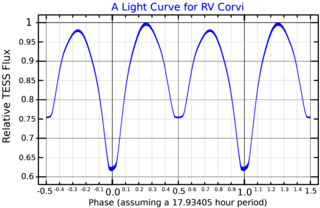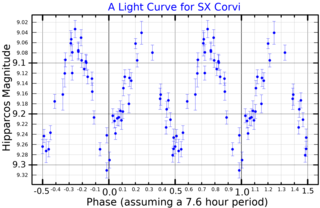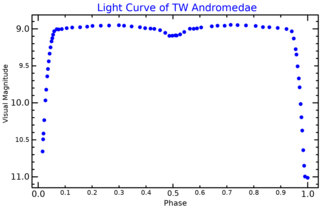
In astronomy, a light curve is a graph of light intensity of a celestial object or region as a function of time, typically with the magnitude of light received on the y axis and with time on the x axis. The light is usually in a particular frequency interval or band. Light curves can be periodic, as in the case of eclipsing binaries, Cepheid variables, other periodic variables, and transiting extrasolar planets, or aperiodic, like the light curve of a nova, a cataclysmic variable star, a supernova or a microlensing event or binary as observed during occultation events. The study of the light curve, together with other observations, can yield considerable information about the physical process that produces it or constrain the physical theories about it.

Corvus is a small constellation in the Southern Celestial Hemisphere. Its name means "crow" in Latin. One of the 48 constellations listed by the 2nd-century astronomer Ptolemy, it depicts a raven, a bird associated with stories about the god Apollo, perched on the back of Hydra the water snake. The four brightest stars, Gamma, Delta, Epsilon, and Beta Corvi, form a distinctive quadrilateral in the night sky.

S Antliae is a W Ursae Majoris-type eclipsing binary star in Antlia.

RV Corvi is an eclipsing binary star system in the southern constellation of Corvus. The brightness of the pair regularly ranges in apparent visual magnitude from 8.6 down to 9.16 over a period 18 hours, even the brightest of which is too faint to be visible to the naked eye. The system is located at a distance of approximately 690 light-years from the Sun based on parallax measurements, and is drifting further away with a radial velocity of ~19 km/s.

SX Corvi is an eclipsing binary star system in the constellation Corvus, ranging from apparent magnitude 8.99 to 9.25 over 7.6 hours. The system is a contact binary also known as a W Ursae Majoris variable, where the two component stars orbit closely enough to each other for mass to have been transferred between them—in this case the secondary having transferred a large amount of mass to the primary.

TV Corvi, also known as Tombaugh's Star, is a dwarf nova of the SU Ursae Majoris type in the constellation Corvus that was first discovered by accident as a mysterious 12th magnitude star on a plate by Clyde Tombaugh while looking for remote planets on May 25, 1932, before its identity was confirmed as a dwarf nova by David Levy in 1990.

TW Andromedae is an eclipsing binary star, classified also as an Algol variable star, in the constellation Andromeda. Its brightness varies with a period of 4.12 days, and has a typical brightness of magnitude 8.98 but decreasing down to a magnitude of 11.04 during the main eclipse.

AB Andromedae is a binary star in the constellation Andromeda. Paul Guthnick and Richard Prager discovered that the star is an eclipsing binary in 1927. Its maximum apparent visual magnitude is 9.49 but shows a variation in brightness down to a magnitude of 10.46 in a periodic cycle of roughly 8 hours. The observed variability is typical of W Ursae Majoris variable stars, so the two stars in this system form a contact binary.

V752 Centauri is multiple star system and variable star in the constellation of Centaurus. An eclipsing binary, its apparent magnitude has a maximum of 9.10, dimming to 9.66 during primary eclipse and 9.61 during secondary eclipse. Its variability was discovered by Howard Bond in 1970. From parallax measurements by the Gaia spacecraft, the system is located at a distance of 410 light-years from Earth.

DH Cephei is a variable binary star system in the northern circumpolar constellation of Cepheus, positioned about two degrees to the east of the star system Delta Cephei. With an apparent visual magnitude of 8.61, it is too faint to be visible without a telescope. Based on parallax measurements, this system is located at a distance of approximately 9.6 kilolight-years from the Sun. At present it is moving closer to the Earth with a radial velocity of −33 km/s.

UX Ursae Majoris is an Algol type binary star system in the northern circumpolar constellation of Ursa Major. It is classified as a nova-like variable star similar to DQ Herculis, although no eruptions have been reported. Since its discovery in 1933, this system has been the subject of numerous studies attempting to determine its properties. The combined apparent visual magnitude of UX UMa ranges from 12.57 down to 14.15. The system is located at a distance of approximately 952 light years from the Sun based on parallax, and is drifting further away with a radial velocity of 112 km/s.

XY Ursae Majoris is a short period binary star system in the northern circumpolar constellation of Ursa Major. It is an eclipsing binary with a baseline apparent visual magnitude of 9.50. The system is located at a distance of 221.5 light years from the Sun based on parallax measurements, but is drifting closer with a radial velocity of −10 km/s. It has a relatively high proper motion, traversing the celestial sphere at the angular rate of 0.191″·yr−1.

EQ Tauri is a triple star system in the equatorial constellation of Taurus that includes a contact eclipsing binary. The system is too faint to be viewed with the naked eye, having a baseline apparent visual magnitude of 10.5. During the primary eclipse, the brightness of the system drops to magnitude 11.03, then to 10.97 during the secondary minimum. The secondary eclipse is total. Based on parallax measurements, it is located at a distance of approximately 730 light years from the Sun.

SZ Piscium is a suspected triple star system in the equatorial constellation of Pisces. The inner pair form a double-lined spectroscopic binary with an orbital period of 3.966 days. It is a detached Algol-type eclipsing binary of the RS Canum Venaticorum class with a subgiant component. The system is too faint to be readily visible to the naked eye with a combined apparent visual magnitude of 7.18. It is located at a distance of approximately 306 light years based on parallax measurements.

BH Virginis is a binary star system in the equatorial constellation of Virgo. With a typical apparent visual magnitude of 9.6, it is too faint to be visible to the naked eye. Based on parallax measurements, it is located at a distance of approximately 488 light years from the Sun. The system is drifting closer with a net radial velocity of −23 km/s.

RW Tauri is a binary star system in the equatorial constellation of Taurus. It has the designation HD 25487 in the Henry Draper Catalogue, while RW Tauri is the variable star designation. With a peak apparent visual magnitude of 8.05, it is too faint to be visible to the naked eye. The distance to this system is approximately 940 light years based on parallax measurements.

ER Vulpeculae is a binary star system in the northern constellation of Vulpecula, abbreviated ER Vul. It is a variable star system with a brightness that ranges from an apparent visual magnitude of 7.27 down to 7.49, which is too faint to be visible to the naked eye. This system is located at a distance of 165 light years from the Sun based on parallax measurements. It is drifting closer with a radial velocity of −25 km/s.

VV Ursae Majoris is a binary star system in the northern circumpolar constellation of Ursa Major, abbreviated VV UMa. It is a variable star system with a brightness that cycles around an apparent visual magnitude of 10.19, making it too faint to be visible to the naked eye. The system is located at a distance of approximately 1,500 light years based on parallax measurements.

AW Ursae Majoris is a binary star system in the northern circumpolar constellation of Ursa Major, abbreviated AW UMa. It is an A-type W Ursae Majoris variable with an apparent visual magnitude of 6.83, which is near the lower limit of visibility to the naked eye. This is an eclipsing binary with the brightness dropping to magnitude 7.13 during the primary eclipse and to 7.08 with the secondary eclipse. Parallax measurements give a distance estimate of 221 light years from the Sun. It is drifting closer to the Sun with a radial velocity of approximately −17 km/s. The system has a high proper motion, traversing the celestial sphere at the rate of 0.216 arc second per annum.

RT Persei is a variable star system in the northern constellation of Perseus, abbreviated RT Per. It is an eclipsing binary system with an orbital period of 0.84940032 d (20.386 h). At peak brightness the system has an apparent visual magnitude of 10.46, which is too faint to be viewed with the naked eye. During the eclipse of the primary this decreases to magnitude 11.74, then to magnitude 10.67 with the secondary eclipse. The distance to this system is approximately 628 light years based on parallax measurements. It is drifting closer with a heliocentric radial velocity of about −12 km/s.




















